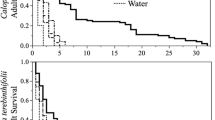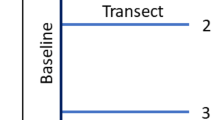Abstract
Parthenium hysterophorus (Asteraceae: Heliantheae) (parthenium weed), one of the most aggressive terrestrial weeds, has wide-ranging negative impacts on crop and animal production, biodiversity conservation, and human and animal health in Africa, Asia and Australia. In 2010, South Africa imported the biological control agent, Epiblema strenuana (Lepidoptera: Tortricidae), into quarantine for testing. It is one of the most widespread and damaging agents to have established on parthenium weed in Australia and China. However, it was rejected in India for completely developing on Guizotia abyssinica (Asteraceae: Heliantheae) during laboratory testing. Although G. abyssinica is not cultivated in South Africa, if E. strenuana were to be released here, there are concerns that the moth could readily reach East Africa (where G. abyssinica is an important native commercial oil crop in some countries) due to its dispersal ability and broad host acceptance across several genera. As a matter of responsibility, initial host-range testing in South Africa focussed on determining the susceptibility of selected Ethiopian cultivars of G. abyssinica. Under no-choice conditions, E. strenuana completed development on only one of five test cultivars. However, significant larval feeding damage was recorded on all cultivars. During multiple-choice studies, E. strenuana did not complete development on any of the cultivars, and significantly reduced larval feeding damage was recorded as compared to damage in no-choice tests. Larval development studies showed gall formation and adult eclosion on four cultivars. The interpretation of these results concluded with a decision by South African researchers in 2012 to deprioritise E. strenuana as a potential biological control agent, at least until its host range and potential impact on non-target species in Africa were resolved through field host range trials in Australia.

Similar content being viewed by others
References
Adkins SW, Navie SC (2006) Parthenium weed: a potential major weed for agro-ecosystems in Pakistan. Pak J Weed Sci Res 12(1–2):19–36
Adkins S, Shabbir A (2014) Biology, ecology and management of the invasive parthenium weed (Parthenium hysterophorus L.). Pest Manag Sci 70:1023–1029
Alhammadi ASA (2010) Preliminary survey of exotic invasive plants in some western and high plateau mountains in Yemen. Assiut Univ Bull Environ Res 13(1):1–11
Atinafu DG, Shamshad KB, Libsu S (2015) Quality characterisation of Niger seed oil (Guizotia abyssinica Cass.) produced in Amahara regional state, Ethiopia. Afr J Biotechnol 14(3):171–174
Baagøe J (1974) The genus Guizotia (Compositae). A taxonomic revision. Bot Tidsskr 69:1–39
Boulos L, El-Hadidi MN (1984) The weed flora of Egypt. American University of Cairo Press, Cairo
Brunel S, Panetta D, Fried G, Kriticos D, Prasad R, Lansink AO, Shabbir A, Yaacoby T (2014) Preventing a new invasive alien plant from entering and spreading in the Euro-Mediterranean region: the case study of Parthenium hysterophorus. Bull OEPP/EPPO Bull 44(3):479–489
Dhileepan K (2003) Seasonal variation in the effectiveness of the leaf-feeding beetle Zygogramma bicolorata (Coleoptera: Chrysomelidae) and stem-galling moth Epiblema strenuana (Lepidoptera: Tortricidae) as biocontrol agents on the weed Parthenium hysterophorus (Asteraceae). Bull Entomol Res 93:393–401
Dhileepan K, McFadyen RE (2001) Effects of gall damage by the introduced biological control agent Epiblema strenuana (Lep., Tortricidae) on the weed Parthenium hysterophorus (Asteraceae). J Appl Entomol 125:1–8
Dhileepan K, McFadyen RE (2012) Parthenium hysterophorus L.—parthenium. In: Julien M, McFadyen R, Cullen J (eds) Biological control of weeds in Australia. CSIRO Publishing, Melbourne, pp 448–462
Dhileepan K, Strathie L (2009) Chapter 15: Parthenium hysterophorus L. (Asteraceae). In: Muniappan R, Reddy GVP, Raman A (eds) Biological control of tropical weeds using arthropods. Cambridge University Press, Cambridge, pp 272–316
Florentine SK, Raman A, Dhileepan K (2005) Effects of gall induction by Epiblema strenuana on gas exchange, nutrients, and energetics in Parthenium hysterophorus. BioControl 50:787–801
Getinet A, Sharma SM (1996) Niger. Guizotia abyssinica (L. f.) Cass. Promoting the conservation and use of underutilized and neglected crops, vol 5. Institute of Plant Genetics and Crop Plant Research, Gatersleben/International Plant Genetic Re-sources Institute, Rome, p 58
Hedberg I, Edwards S (1989) Flora of Ethiopia and Eritrea, Pittosporaceae to Araliaceae, vol 3. The National Herbarium, Addis Ababa, Asmara, Uppsala, p 660
Hiremath SC, Murthy HN (1988) Domestication of niger (Guizotia abyssinica). Euphytica 37:225–228
Jayanth KP (1987) Investigations on the host specificity of Epiblema strenuana Walker (Lepidoptera: Tortricidae), introduced for biological control trials against Parthenium hysterophorus in India. J Biol Control 1:133–137
Kilian N, Hein P, Hubaishan MA (2002) New and noteworthy records for the flora of Yemen, chiefly of Hadhramout and Al-Mahra. Willdenowia 32:239–269
Mackay MR (1959) Larvae of the North American Olethreutidae (Lepidoptera). Can Entomol Suppl 10:1–338
Mahmoud T, Gairola S, El-Keblawy A (2015) Parthenium hysterophorus and Bidens pilosa, two new records to the invasive weed flora of the United Arab Emirates. J N Biol Control Rep 4(1):26–32
McClay AS (1987) Observations on the biology and host specificity of Epiblema strenuana (Lepidoptera, Tortricidae), a potential biocontrol agent for Parthenium hysterophorus (Compositiae). Entomophaga 32(1):23–34
McClay AS, Palmer WA, Bennet FD, Pullen KR (1995) Phytophagous arthropods associated with Parthenium hysterophorus (Asteraceae) in North America. Environ Entomol 24(4):796–809
McConnachie AJ, Strathie LW, Mersie W, Gebrehiwot L, Zewdie K, Abdurehim A, Abrha B, Araya T, Asaregew F, Assefa F, Gebre-Tsadik R, Nigatu L, Tadesse B, Tana T (2011) Current and potential geographical distribution of the invasive plant Parthenium hysterophorus (Asteraceae) in eastern and southern Africa. Weed Res 51:71–84
McFadyen RC (1992) Biological control against parthenium weed in Australia. Crop Prot 11:400–407
Raman A, Dhileepan K (1999) Qualitative evaluation of damage by Epiblema strenuana (Lepidoptera: Tortricidae) to the weed Parthenium hysterophorus (Asteraceae). Ann Entomol Soc Am 92(5):717–723
Sithole HJN, McDonald IAW (2013) What’s in a name?—Directing the ‘common naming’ of invasive alien species. In: Poster during the EPPO/CoE/ICN ISSG international workshop ‘How to communicate on pests and invasive alien plants?’ Oerias, Portugal, 2013-10-08/10
Strathie LW, McConnachie AJ, Retief E (2011) Initiation of biological control against Parthenium hysterophorus L. (Asteraceae) in South Africa. Afr Entomol 19(2):378–392
Tamado T, Milberrg P (2000) Weed flora in arable lands of Eastern Ethiopia with emphasis on the occurrence of Parthenium hysterophorus. Weed Res 40:507–521
van Klinken RD, Julien MH (2003) Learning from past attempts: does classical biological control of Noogoora Burr (Asteraceae: Xanthium occidentale) have a promising future? Biocontrol Sci Technol 13:139–153
Wabuyele E, Lusweti A, Bisikwa J, Kyenune G, Clark K, Lotter WD, McConnachie AJ, Mersie WA (2014) Roadside survey of the invasive weed Parthenium hysterophorus (Asteraceae) in East Africa. J East Afr Nat Hist 103(1):49–57
Yaacoby T, Seplyarsky V (2011) Epiblema strenuana (Walker, 1863) (Lepidoptera: Tortricidae), a new species in Israel. EPPO Bull 41:243–246
Zahran MA, Willis AJ (2009) Chapter 6. The Nile region. In: Zahran MA, Willis AJ (eds) The vegetation of Egypt. Springer, London, pp 251–303
Zhou ZS, Chen HS, Zheng XW, Guo JY, Guo W, Li M, Luo M, Wan FH (2014) Control of the invasive weed Abrosia artemisiifolia with Ophraella communa and Epiblema strenuana. Biocontrol Sci Technol 24(8):950–964
Acknowledgments
L. Strathie, M. Gareeb, L. Khumalo, D. Nkala, M. Binedell, S. Mqolombeni (all of ARC-PPRI), are thanked for their technical and research contributions to the project. L. Strathie is also thanked for comments on a final draft of the manuscript. We thank R. McFadyen (retired, previously of CRC for Weed Management, Australia), K. Dhileepan and M. Trevino (Queensland DEEDI, Australia) for their expertise, advice, logistical support, and provision of biocontrol agents. We gratefully acknowledge financial support from the Department of Environmental Affairs (DEA) National Resource Management Programmes (NRMP), the KwaZulu-Natal Department of Agriculture, Environment and Rural Development’s Invasive Alien Species Programme, the Agricultural Research Council, as well as the Agriculture Office within the Bureau for Economic Growth, Agriculture, and Trade (EGAT) of the US Agency for International Development, under the terms of the Integrated Pest Management Collaborative Research Support Program (IPM CRSP; Award No. EPP-A-00-04-00016-00). The opinions expressed herein are those of the author and do not necessarily reflect the views of the US Agency for International Development.
Author information
Authors and Affiliations
Corresponding author
Additional information
Handling Editor: S. Raghu.
Rights and permissions
About this article
Cite this article
McConnachie, A.J. Host range tests cast doubt on the suitability of Epiblema strenuana as a biological control agent for Parthenium hysterophorus in Africa. BioControl 60, 715–723 (2015). https://doi.org/10.1007/s10526-015-9675-2
Received:
Accepted:
Published:
Issue Date:
DOI: https://doi.org/10.1007/s10526-015-9675-2




